Sean Carroll in Pioneer Works:
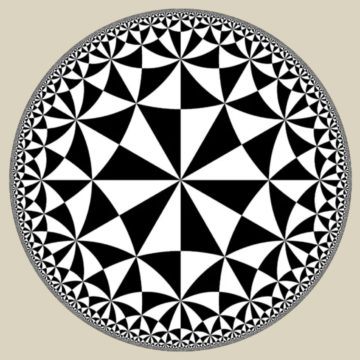 Of Euclid’s five postulates, which form the basis of Euclidean geometry, the fifth is the most controversial. Called the Parallel Postulate, it’s a pretty basic idea. Take a flat piece of paper, draw a line segment and then draw two lines that are perpendicular to it. The Parallel Postulate simply says that the lines will remain forever parallel, staying precisely the same distance apart even if we extend them to infinity on either side of the line segment.
Of Euclid’s five postulates, which form the basis of Euclidean geometry, the fifth is the most controversial. Called the Parallel Postulate, it’s a pretty basic idea. Take a flat piece of paper, draw a line segment and then draw two lines that are perpendicular to it. The Parallel Postulate simply says that the lines will remain forever parallel, staying precisely the same distance apart even if we extend them to infinity on either side of the line segment.
For a long time mathematicians strived to prove the Parallel Postulate using the first four (more) basic postulates, and so elevate it from a postulated axiom to a proven theorem. It turns out that you can’t, and for good reason—the postulate isn’t true for all geometries. Euclidean geometry, represented by the flat piece of paper, and on which lines that start off parallel never intersect, is just one kind of geometry, but there are others. You can imagine replacing the Parallel Postulate with some alternative: maybe lines that are parallel initially draw closer together and touch eventually, or maybe they always move apart. The first option is the case with spherical geometry, which describes shapes drawn on the surface of a sphere (think of lines of longitude that start of parallel at the equator but converge at the poles), while the second defines hyperbolic geometry, which is more like the surface of a saddle or a Pringle’s potato chip.
These non-Euclidean alternatives weren’t noticed for millennia. Euclid himself flourished around 300 BCE, and the first alternatives to the Parallel Postulate were proposed in the early 1800s by Russian mathematician Nikolai Lobachevsky and Hungarian mathematician János Bolyai. Interestingly, both studied the hyperbolic alternative to flat Euclidean geometry.
This raises two questions: First, why did it take so long? And second, why did the mathematicians study hyperbolic geometry before spherical? Everyone knew about spheres. How hard could it have been to imagine drawing some lines on them, and exploring the geometric consequences of doing so?
The questions share a common answer.
More here.
 AT EVERY JOB I’ve ever had in fashion there’s always a certain brand or designer or aesthetic that gets adopted by everyone, no matter their taste or preference, for good reason: it’s good. For the job I most recently worked, I still see it the second I step foot out of my apartment. Friends wear it with sneakers on our hikes up the mountain, people on the subway brush nonexistent dust off of it after sitting down, and there is always that moment of eye contact at the coffee shop between two customers dressed in the same pair of pants. The first time I went to a new dentist, recommended by a colleague, I was wearing mine. The dentist looked me up and down above his clipboard, and rather than ask who referred me gestured at my outfit. “SSENSE,” he said, like a statement.
AT EVERY JOB I’ve ever had in fashion there’s always a certain brand or designer or aesthetic that gets adopted by everyone, no matter their taste or preference, for good reason: it’s good. For the job I most recently worked, I still see it the second I step foot out of my apartment. Friends wear it with sneakers on our hikes up the mountain, people on the subway brush nonexistent dust off of it after sitting down, and there is always that moment of eye contact at the coffee shop between two customers dressed in the same pair of pants. The first time I went to a new dentist, recommended by a colleague, I was wearing mine. The dentist looked me up and down above his clipboard, and rather than ask who referred me gestured at my outfit. “SSENSE,” he said, like a statement.
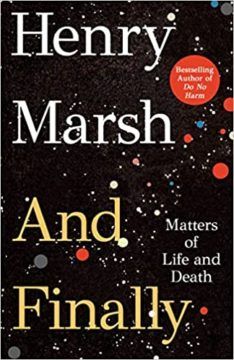 T
T We have tried, in various ways, to convey to the world the scale of destruction caused by recent floods in Pakistan, because, apparently, a third of the country underwater and thirty-three million lives upended doesn’t cut it. Pakistan’s climate minister has called it Biblical. We have shot and shared videos in which the landmark New Honeymoon Hotel crumbles in the duration of a TikTok. The U.N. Secretary-General, António Guterres, who is seventy-three and has called the climate crisis a “
We have tried, in various ways, to convey to the world the scale of destruction caused by recent floods in Pakistan, because, apparently, a third of the country underwater and thirty-three million lives upended doesn’t cut it. Pakistan’s climate minister has called it Biblical. We have shot and shared videos in which the landmark New Honeymoon Hotel crumbles in the duration of a TikTok. The U.N. Secretary-General, António Guterres, who is seventy-three and has called the climate crisis a “ It was not an isolated incident of police violence in Iran. But the death of 22-year-old
It was not an isolated incident of police violence in Iran. But the death of 22-year-old  The word ‘bravery’ is applied all too liberally nowadays.
The word ‘bravery’ is applied all too liberally nowadays. 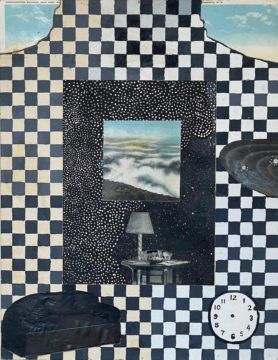 Ted and I saw one another off and on for about five years. In the spring of 1970, we lived together on Saint Mark’s Place in the East Village, until June, when Ted went to teach a course in Buffalo. I moved into the artists Rudy Burckhardt and Yvonne Jacquette’s loft on East Fourteenth Street while they summered in Maine. Ted stayed with me for a number of weekends that summer, and he proposed that we undertake a collaborative book. As I remember, I began the collaboration by making drawings with empty word balloons. I’m pretty sure Ted provided the project’s title at the outset. Ted would take the drawings—I think I made them in batches of four or five—back to Buffalo, where he began to fill in the words. We went back and forth this way, sometimes in person, sometimes by mail. I had forgotten all about this collaboration by the time Ted Berrigan’s youngest son, Eddie, contacted me in the summer of 2018. He wanted to bring me something his father and I had done together, which had recently turned up. As I looked at sixteen pages of my drawings and Ted’s handwritten words, the memories came back. These diaries describe some of them, along with the artistic milieu I was in in New York at that time—which included the painter Martha Diamond and the poets Bernadette Mayer, Michael Brownstein, Anne Waldman, and John Giorno.
Ted and I saw one another off and on for about five years. In the spring of 1970, we lived together on Saint Mark’s Place in the East Village, until June, when Ted went to teach a course in Buffalo. I moved into the artists Rudy Burckhardt and Yvonne Jacquette’s loft on East Fourteenth Street while they summered in Maine. Ted stayed with me for a number of weekends that summer, and he proposed that we undertake a collaborative book. As I remember, I began the collaboration by making drawings with empty word balloons. I’m pretty sure Ted provided the project’s title at the outset. Ted would take the drawings—I think I made them in batches of four or five—back to Buffalo, where he began to fill in the words. We went back and forth this way, sometimes in person, sometimes by mail. I had forgotten all about this collaboration by the time Ted Berrigan’s youngest son, Eddie, contacted me in the summer of 2018. He wanted to bring me something his father and I had done together, which had recently turned up. As I looked at sixteen pages of my drawings and Ted’s handwritten words, the memories came back. These diaries describe some of them, along with the artistic milieu I was in in New York at that time—which included the painter Martha Diamond and the poets Bernadette Mayer, Michael Brownstein, Anne Waldman, and John Giorno.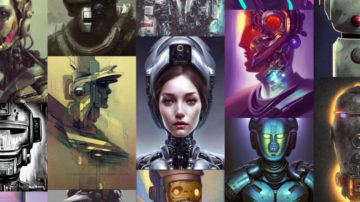 The arrival of widely available image synthesis models such as Midjourney and
The arrival of widely available image synthesis models such as Midjourney and  Of Euclid’s five postulates, which form the basis of Euclidean geometry, the fifth is the most controversial. Called the Parallel Postulate, it’s a pretty basic idea. Take a flat piece of paper, draw a line segment and then draw two lines that are perpendicular to it. The Parallel Postulate simply says that the lines will remain forever parallel, staying precisely the same distance apart even if we extend them to infinity on either side of the line segment.
Of Euclid’s five postulates, which form the basis of Euclidean geometry, the fifth is the most controversial. Called the Parallel Postulate, it’s a pretty basic idea. Take a flat piece of paper, draw a line segment and then draw two lines that are perpendicular to it. The Parallel Postulate simply says that the lines will remain forever parallel, staying precisely the same distance apart even if we extend them to infinity on either side of the line segment. As you read this article, time will seem to pass. Right now, you are reading these words, but now you are reading these ones. What was present just an instant ago seems to have already slipped into the past. You will carry this feeling with you – as objects change and move, as thoughts run through your head, as feelings ebb and flow – until you fall asleep tonight. Heraclitus thought that time was like a river: ‘Everything flows and nothing abides; everything gives way and nothing stays fixed.’ Our experience of the world seems to back this up. It certainly feels as if time is sweeping us along. Yet, physicists and philosophers will tell you that Heraclitus was wrong. Time, they say, does not actually pass. In his
As you read this article, time will seem to pass. Right now, you are reading these words, but now you are reading these ones. What was present just an instant ago seems to have already slipped into the past. You will carry this feeling with you – as objects change and move, as thoughts run through your head, as feelings ebb and flow – until you fall asleep tonight. Heraclitus thought that time was like a river: ‘Everything flows and nothing abides; everything gives way and nothing stays fixed.’ Our experience of the world seems to back this up. It certainly feels as if time is sweeping us along. Yet, physicists and philosophers will tell you that Heraclitus was wrong. Time, they say, does not actually pass. In his 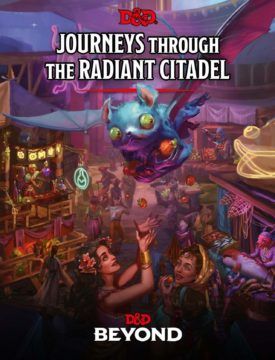 David M. Higgins talks to Ajit George in LA Review of Books:
David M. Higgins talks to Ajit George in LA Review of Books: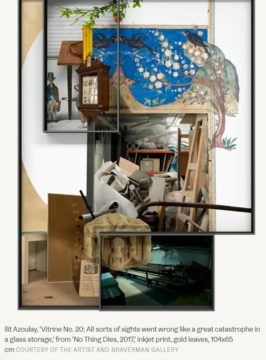 Marco Roth in Tablet:
Marco Roth in Tablet: Sam Roberts in the New York Times:
Sam Roberts in the New York Times: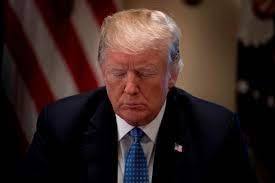 There is a secret. And that secret is how to make top-secret secrets not secret anymore using only your mind. All that stands between you and doing this is embracing the power of positive declassifying. Let others submit formal written declassification requests to the proper agencies. You are special. You are powerful. You are going to jail. The first step is gratitude. Close your eyes—but also maybe keep one open for the F.B.I.—and say meaningful thank-yous to those whose service you will be betraying.
There is a secret. And that secret is how to make top-secret secrets not secret anymore using only your mind. All that stands between you and doing this is embracing the power of positive declassifying. Let others submit formal written declassification requests to the proper agencies. You are special. You are powerful. You are going to jail. The first step is gratitude. Close your eyes—but also maybe keep one open for the F.B.I.—and say meaningful thank-yous to those whose service you will be betraying.